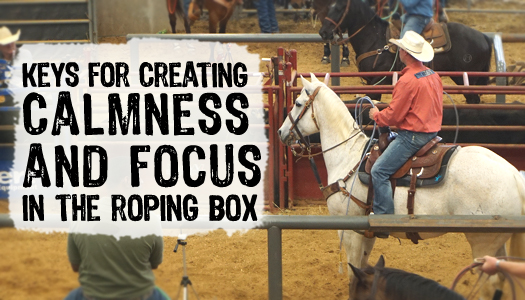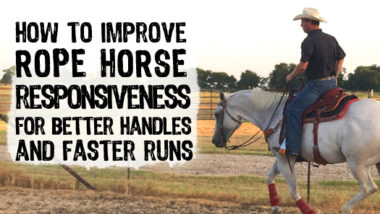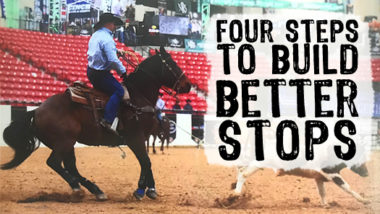Listen to this article in audio form! It’s #5 in the Team Roping Tips Podcast.
For the latest episodes subscribe on iTunes or your favorite podcast app.
Does your horse sometimes struggle with standing still in the box? Or have you ever had a horse freeze up and not respond to your leg when you tried to position them?
Maybe you’ve had a horse who looked to the side and checked out mentally when you needed them to focus forward on the steer.
Horses can struggle with their emotions just like people, often due to the repetitive pressures on them to perform, which is especially common in timed-speed event horses.
These off-balance emotions can lead to distracting behaviors that make it difficult for us to focus on our roping. Because getting a good start in a run is so critical, it can quickly turn into a lose-lose situation for both us and our horse.
Thankfully there’s a lot we can do to resolve less than ideal box behavior, as well as actions we can take to avoid it completely.
When an issue starts to develop, it’s not uncommon for ropers to ignore the indicators horses provide that all is not well in their world, and continue roping despite them.
Sometimes our intention to help them is sincere, but we might not be effective with the teaching or leadership we’re providing, which is necessary for them to completely understand what’s expected and feel confident.
In some cases, we as ropers may not be emotionally fit ourselves, and take out our frustration on our horse for not doing what we want (as a result of the preparation we haven’t provide them), which just compounds the situation.
It’s also common for physical problems to be overlooked that are legitimately contributing to the anxiety horses experience in the box.
We want our rope horses to be alert and responsive, but not reactive. We want them to anticipate without making assumptions.
We want to give our horse every reason to be mentally present and focused, and remove every reason they might have not to be.
If our horse is educated, confident and emotionally fit, our ability to work together as a successful team dramatically increases.
Calm, But Alert.
Relaxed, But Ready.
Smooth, But Sharp.
Humble, But Confident.
Thoroughly preparing our horses from the start is the best way to build confidence, reduce stress and avoid box problems. By educating our horses to yield their body parts any time or any place, and be responsive & soft in the face, this gives us a solid foundation of communication to advance into roping.
Exposure to roping gradually also helps build confidence. It’s ideal to give horses time to accept clanging gates, steers bellering, and the sight and sound of ropes swinging over their heads, etc.
If we take these steps, when it comes time to introduce them to pressure of roping, they’ll already be pretty understanding and confident. If this process is overlooked, it’s never too late to go back and rebuild an older horse’s education and acceptance.
As we progress with any horse, we must watch for subtle signs that they might be having trouble emotionally and getting anxious. Not all horses will display the same signs. Some horses may show very outward, obvious symptoms, while others will hold it in under the surface. Either way it’s important to take action immediately.
We can create mental connection and relaxation in our horse by moving their feet while also asking for flexion in their body. When we get their feet moving and bodies supple, it tends to free up and release brace in their mind as well.
By causing our horse to mentally connect to us, we can give them the comfort of knowing that we have everything under control and their best interest in mind.
When you feel a horse make a subtle shift from being reactive and tense to physically and mentally softening, reward them by relaxing and allowing them a rest. Let them sit there and process – reward their relaxation with more relaxation to ‘teach’ the mental state you want.
Sometimes our horses are giving us feedback due to physical discomfort they’re experiencing. This could be from ulcers or soreness. Tail swishing, mouth gapping, head tossing, rough, choppy movement, etc. are a few examples of symptoms we don’t want to overlook.
It’s important to take action on any of these issues immediately as well so that they don’t interfere when it’s time to compete. We’re much better off addressing issues while they’re still small, before major behavioral problems have developed secondarily.
Balancing out the stress of roping with adequate relaxation in our horses is also critical. We need to create the relaxation and then test it out, then reestablish it and repeat again as necessary until we reach a point where our horses are fully confident and calm, yet also ready to perform at their best.
Scoring is a big way to create this balance. With some horses, you might need to score more steers than you rope. Make the scoring as realistic as possible by going through the same actions you would as if we were going to make a run. Horses can tell the difference. Only nod your head when they can stand straight, calm and focused.
After the gate opens in practice, you can sometimes mix things up by riding them up to the front of the chute and letting them stand there. Give them some slack in the reins if you can and just wait for a sign that they are releasing stress, which could be lowering their head, licking their lips or blowing out. Don’t allow your horse to leave the box unless they can do it at a calm, flat-footed walk. Wait and release on something positive.
Roping machines like a Heel-O-Matic are another great way to train our horse in a simulated environment that we have control over. Follow the machine around the arena at a slower pace, while also asking for your horse to lower his head. When he softens and blows out, stop and reward him or offer smaller, ‘micro-releases’ as you go.
Don’t worry too much about roping the machine until you have quality softness and relaxation. Only build up in speed and swing your rope once you have relaxation and softness at slower speeds. This could take a few days or a few weeks to re-establish in some cases.
Keep in mind that no matter how talented the horse or good your roping skills – that your performance together will never be quite as good with brace, tension, anxiety and distraction present as it would be without it. Fixing box problems thoroughly, or correcting course before they fully develop is always worthwhile – and it’s done by prioritizing fundamentals with time, patience and quality horsemanship.
After a run let your rope go and ask your horse to wait sometimes before retrieving it at the stripping chute. Don’t allow your horse to ‘practice’ by jigging down the arena if you can – redirect their focus and ask for bend at every opportunity to interrupt their habits of getting anxious, stiff and tense. Get off your horse as soon as possible after a run and hand walk them. The more, and the sooner a horse relaxes, the better they get at it, and the easier it is to return there emotionally.
Several back to back runs without a break can cause our horses to build up anticipation in the box every time we ride in to make another run. By intentionally helping our horses come down and process each run, then actually reward their more positive state of mind, it’s a way to decrease the stress level before the next run, instead of letting it increase.
Outside riding is another good way to take pressure off our horses in general. It provides a great opportunity to give them a different perspective by getting their mind off the intense work in arena. A change of scenery or a different job to focus on now & then can raise their curiosity and loosen up their mind to create some balance.
As ropers, we also need to be able to separate our emotions from our horse’s emotions. We need to become more emotionally fit ourselves, and not allow our horse’s emotions dictate our own. Sometimes we need to match their energy, but we can do that without getting tense or frustrated. They are a reflection of us. If our horse is struggling emotionally, we need to have some understanding and empathy for them. It’s up to us to help them through it in a positive way that benefits them, which in turn will benefit our roping. We’ve got to be mature and responsible about it.
“Leadership is not about being in charge. Leadership is about taking care of those in your charge.” – Simon Sinek
We might be carrying emotional baggage to the arena that doesn’t belong there. No matter what it might be, we can’t allow our personal issues influence our roping. All we can do is our best and turn the results over. Getting upset or emotional is optional. It’s a choice that’s within our control. We have to practice choosing thoughts and beliefs that help our roping, not hinder it.
For example, every frustration or problem that comes up is one that can help us be better. They can all work out in our favor if we decide to perceive our challenges that way.
Depending on the horse, it may take more time and effort to achieve the relaxation we’re looking for in some more so than others. Be prepared to take whatever time it takes. Some of the most talented horses are very sensitive and will tend to require more mental maintenance. When we go out of our way to provide what they need though, it can be well worth it in the end.
When our horses are thoroughly educated, prepared, and mentally & emotionally fit, we’re able to work together as a high performing team. We can focus on our job, be effective, continuously improve and enjoy every step of the process.
There is no better feeling backing in the box when the lights are bright, the music is loud, and you have the highest level of confidence in your horse and are both able to be 100% in the zone and focused on nothing but making a great run.
I hope this article helps create that feeling for you & your horses!
If you’d like more support beyond what I’ve shared in this post, click here to learn about video coaching and be sure you’re subscribed to receive updates and new roping tips when they’re published at CraigSmithTeamRoping.com.


